|
| |||||||||||||||||||||||||||||||||||||||||||||||||||

| ||||||||||||||||||||||||||||||||||||||||||||||||||||
|
MobiSys '03 Paper
[MobiSys '03 Tech Program Index]
Energy-Adaptive Display System Designs
| |||||||||||||||||||||||||||||||||||||||||||||||||||||||||||||||||||||||||||||||||||||||||||||||||||||||||||||||||||||||||||||||||||||||||||||||||||||||||||||||||||||||||||||||||||||||||||||||||||||||||||||||||||||||||||||||||||||||||||||||
| Subu Iyerf | Lu Luo |
Robert Mayof | Parthasarathy Ranganathanf |
|
f Hewlett Packard Labs 1501 Page Mill Road MS 1177 Palo Alto California 94304 USA {Subu.Iyer,Bob.Mayo}@hp.com Partha.Ranganathan@hp.com
|
Carnegie Mellon University Pittsburgh, Pennsylvania 15213 USA luluo@cs.cmu.edu |
Previous approaches to reducing display power consumption have either focused on aggressively turning off the entire display when it is not being used or have resorted to designing systems with lower-quality or smaller sized displays to minimize power. However, new technologies, such as Organic Light Emitting Diodes (OLEDs), are becoming available that allow lower power consumption when a reduced area of the screen is in use. We propose utilizing this new flexibility to reduce energy consumption. Our work is based on the intuition that different workloads and users have varying display needs. Having a "one-size-fits-all" display targeted at the needs of the most aggressive workload/user often leads to large energy inefficiencies in the display energy consumptions of other workloads and users. Consequently, an energy-adaptive system design that consumes energy only on portions and characteristics of the screen that are being used by the application and are relevant to the user, can achieve energy benefits.
In this work, we make two key contributions. First, we perform a detailed characterization of the display screen usage of a representative test user population. Our results indicate that, on average, our users use only about 60% of the screen area available to them. Additionally, screen usage is often associated with content that could have been equivalently displayed, with no loss in visual quality, on much simpler lower-power displays (lower size, resolution, color, brightness, refresh rates, etc.) Using a detailed analysis of the user traces, we also correlate our results to user and application behavior. To the best of our knowledge, our work is the first to identify, quantify, and analyze such mismatch opportunities in workload/user needs and current display properties. Overall, our results indicate that an energy-adaptive system design that matches display power consumption to the functionality required by the workload/user can significantly reduce the energy consumption of future display sub-systems.
Building on the insights from the above analysis, we propose example energy-adaptive display system designs. At the hardware level, our designs leverage emerging Organic LED (OLED) displays [3] that use energy proportional to the overall light output of the display. At the software level, we propose dark windows optimizations that enable the windowing environment to change the brightness and color of areas of the screen that are not of interest to the user. We model the power benefits and study the user experience with our designs. Our results indicate significant, though user-specific, energy reductions with acceptable user interfaces.The rest of the paper is organized as follows. Section 2 discusses our user study in greater detail. Section 3 discusses the example energy-adaptive display systems that we consider and our experiences with those. Section 4 further explores the design space with energy-adaptive displays and Section 5 discusses related work. Section 6 concludes the paper and discusses future work.
| Screen usage for active samples | |||||||
| User | Display | Log length | Active samples | Mean | Std. dev | Mean | Std. dev |
| (column 2) | (column 3) | (column 4) | Window of focus | Background windows | |||
| Desktop user population | |||||||
| 1 | 19" 1024x768 | 210 hours | 33 hours | 62.8% | 38.5% | 10.6% | 21.2% |
| 2 | 21" 1280 x 1024 | 346 hours | 61 hours | 57.2% | 22.3% | 11.6% | 28.5% |
| 3 | 19" 1280 x 1024 | 214 hours | 31 hours | 46.3% | 19.7% | 30.4% | 19.7% |
| 4 | 19" 1280 x 1024 | 64 hours | 43 hours | 36.7% | 14.5% | 34.1% | 8.8% |
| 5 | 19" 1280 x 1024 | 253 hours | 27 hours | 44.5% | 22.7% | 32.6% | 21.1% |
| 6 | 21" 1280 x 1024 | 229 hours | 31 hours | 55.5% | 18.4% | 24.7% | 17.8% |
| 7 | 21" 1280 x 1024 | 235 hours | 30 hours | 57.5% | 19.2% | 20.0% | 18.8% |
| 8 | 17" 1024 x 768 | 135 hours | 13 hours | 85.2% | 26.2% | 9.7% | 24.4% |
| Laptop user population | |||||||
| 9 | 13" 1280 x 1024 | 42 hours | 23 hours | 61.8% | 21.6% | 25.1% | 22.3% |
| 10 | 14" 1024 x 768 | 98 hours | 54 hours | 71.1% | 25.4% | 22.4% | 23.9% |
| 11 | 14" 1400 x 1050 | 57 hours | 57 hours | 37.4% | 20.3% | 7.2% | 15.1% |
| 12 | 14" 1024 x 768 | 20 hours | 13 hours | 93.7% | 12.3% | 2.3% | 12.2% |
| 13 | 15" 1024 x 768 | 169 hours | 154 hours | 43.3% | 38.9% | 17.5% | 24.3% |
| 14 | 13" 800 x 600 | 132 hours | 6.2 hours | 71.1% | 37.6% | 3.0% | 15.0% |
| 15 | 14"1024 x 768 | 9 hours | 6.4 hours | 44.1% | 21.4% | 10.3% | 15.3% |
| 16 | 14" 1400 x 1050 | 69 hours | 15 hours | 54.6% | 25.9% | 18.5% | 17.5% |
| 17 | 14" 1024x768 | 10 hours | 6.0 hours | 77.3% | 36.8% | 5.0% | 17.0% |
| Average screen usage - window of focus: 58.8%; background windows: 16.7% | |||||||
An application-level logger program was run on the users' machines for times ranging from 1 to 14 days. The logger program was used to collect periodic information about (i) the current window of focus - its size, its location, and its title and (ii) the size of total screen area used (all non-minimized windows). Our sampling rate was set to once a second. Screen savers were set to turn on after a reasonable time (1-5 minutes) to allow us to isolate only the usage patterns when the user was active.
Column 3 in Figure 1 summarizes the length of the user traces. The traces range from 9 hours to 346 hours. The variation in the traces represent the differences in how individual users used their machines during their participation in the study. Overall, our samples represent close to 100 days of continuous computer usage time.Column 4 in Figure 1 summarizes the length of the "active" user traces, after factoring out the time spent in the screen saver as an indication of the time the user was idle. Traces are still collected during the time it takes for the screen saver to be activated, but given the length of our logs, the effect of this is minor. The sizes of our active user logs range from about 6 hours to 61 hours of computer usage per user. Given that this is the time we are interested in, the rest of the paper will focus on the active window usage without considering the time spent in the screen saver. Existing technologies can save power spent in the idle time by turning off the displays.
Focusing on the average screen usage for the window of focus from Figure 1, we can see that our test population uses anywhere from 37% to 94% of the total screen area available to them. An additional 2% to 34% of the screen is used by other background windows that are not active, yet are not minimized. The last row of Figure 1 indicates the average usage across our user population. This average is obtained by computing the arithmetic mean of the averages of the individual users. This ensures that the average is not biased by users with larger log lengths. On average, across all our users, typically only about 59% of the entire screen area is used by the window of focus, the primary area of interest to the user. An additional 17% of the screen, on average, is used for background windows that are not minimized. In both these cases, however, the standard deviations are fairly high indicating a wide range in the screen usage values associated with each sample.
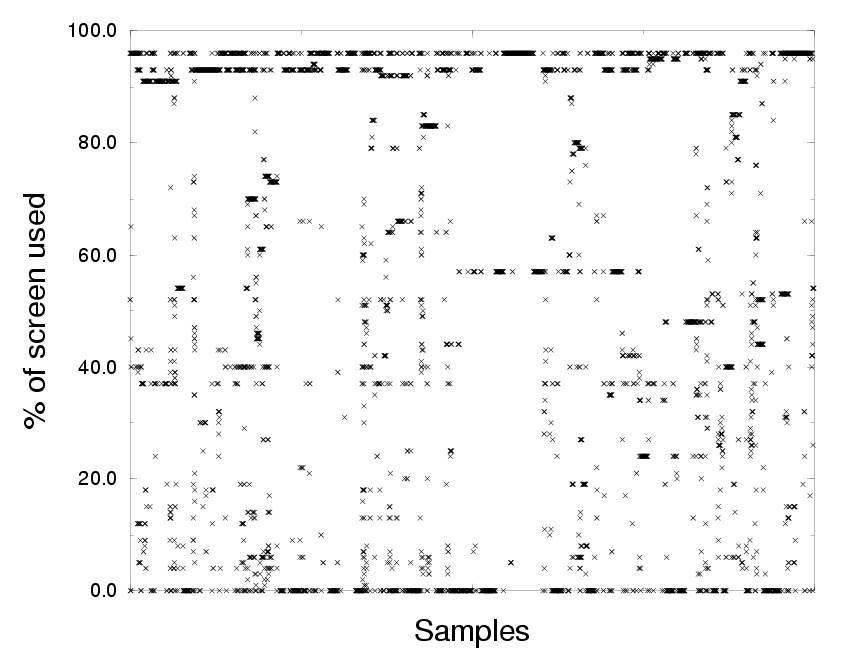
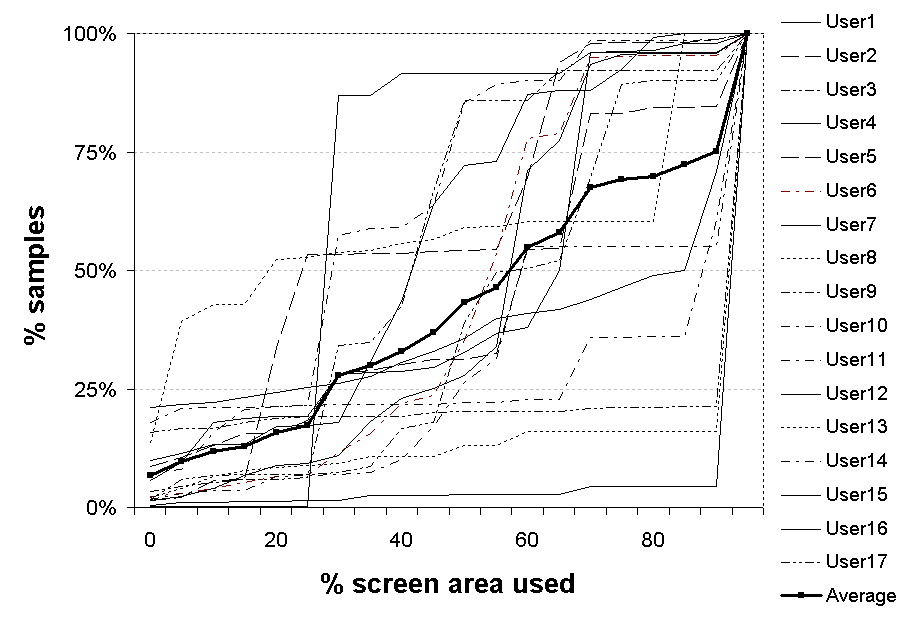
Screen usage distribution. To better understand the distribution of the screen usage characteristics, Figure 2 plots the variation in the screen usage of the window of focus for one sample user, over the log collection period. Each point represents the average screen area associated with one data sample in the log. As can be seen from the figures, the percentage of screen usage varies significantly over the time the data was collected, all the way from near-0 to near-100% usage of the screen. Clustering of points at specific screen usage percentages can be correlated back to the continuous usage of key applications used by the user and their normal (or default) sizes.
Figure 3 presents the same data for all the users in a summarized manner. Each line in the graph represents one user from our test population and the thicker solid line represents values averaged over all the users. The X-axis represents the percentage of screen area used per sample and is divided into bins of 5 each. The Y axis represents the cumulative number of samples associated with each screen-area-percentage bin. For example, if we were to draw a vertical line from the 50% screen area point to intersect all the lines, that would give us the cumulative number of samples where each user uses less than 50% of the total available screen area. For example, focusing on User 5, this would mean that close to 54% of the samples use less than 50% of the screen area.
Summarizing the results in the graph, we can observe that, on average, across all our users, for almost 45% of the time, we end up using less than half the entire screen area. Some users spend more time in windows less than half the screen area (for example, User 4 spends more than 90% of their time in windows that are typically less than 25% of the total screen area).
| Active area is 0-25% (23% of the time for typical user) |
| Key applications: 20% Task bar, 15% Program Manager, 5% X-term, 60% miscellaneous windows (message composition, MSN messenger, real player, menu and message windows - properties, connection status, file downloads, alerts and reminders, volume control, printer status, find-and-replace, organizer preferences, file explorer, spell-check, wizards, status messages, file-find, password query windows, confirmation windows) |
| Active area is 25-50% (22% of the time for typical user) |
| Key applications: 19% X-term, 18% message composition, 6% internet explorer, 57% miscellaneous windows (mail-related windows, file explorer, emacs and notepad, MSN messenger chat windows, other status windows) |
| Active area is 50-75% (28% of the time for typical user) |
| Key applications: 33% Internet Explorer, 24% mail composition and reading, 43% miscellaneous windows (emacs and notepad, Image editor and photo viewer, messenger chat windows, Frontpage, Framemaker and ghostview, file explorer, Powerpoint, dreamweaver, winlogger) |
| Active area is 75-100% (27% of the time for typical user) |
| Key applications: 21% Outlook, 20% Internet Explorer, 7% Excel, 52% miscellaneous windows (Powerpoint, Framemaker, Acrobat reader, Word [various files], Visual C++ [various files]), Dreamweaver, Imageviewer) |
Screen usage corresponding to application behavior. In order to understand the relationship between the screen usage and the application behavior, we took the samples from each of our user logs and categorized them into four bins - (i) samples where the window of focus usage was between 0 and 25% of the total screen area, (ii) samples where the window of focus usage was between 25% and 50%, (iii) samples where the window of focus usage was between 50% and 75%, and (iv) samples where the window of focus usage was between 75% and 100%. For each bin, we then analyzed the key applications associated with the samples. Figure 4 summarizes our results. As before, we compute the arithmetic mean of the averages per individual users to avoid distortions due to trace lengths.
Overall, the workloads used by our user population span a range of applications representative of typical system usage. Broadly, they can be categorized into (i) access related - web browsing and e-mail (Internet Explorer, Netscape, Outlook, Pachyderm mail reader, Messenger), (ii) personal productivity and code development (Word, Emacs, Powerpoint, Excel, Visual studio, Dreamweaver, X-term, Realplayer, Image viewer, Acrobat reader, Ghostview), and (iii) system related and application control windows (File Explorer, navigation windows, taskbars, menus, status and properties messages, confirmation and password query windows).
Focusing on the windows associated with the various applications, we observe two interesting trends. First, system-related status messages and query windows typically use small window sizes; in fact, these windows constitute a significant fraction of the samples associated with smaller size windows. Additionally, these windows usually display fairly low content that do not need the aggressive characteristics of the display - for example, a low-resolution display with support for a small number of colors would be adequate to obtain an equivalent user experience. Second, personal-productivity applications and development environments and web-browsing and e-mail applications typically use larger portions of the display area. The actual fraction of the screen area used appears to be highly dependent on individual user preferences for window size, fonts, etc. However, even with these large windows, characteristics of the displays such as resolution, brightness, and color are not used to their full capacity.
Screen usage corresponding to user behavior. Focusing on the individual user logs, we observe that individual user preferences and pre-set defaults tend to significantly influence the overall screen usage characteristics. For example, User 1 who, on average uses 63% of the display area, has Internet Explorer set to use 96% of the screen area, while User 5 who, on average uses 37% of the display area, has Internet Explorer set to use 67% of the display area. Similarly, User 12, who has the largest screen usage in our study, has a default mail composition window of 95% that dominates the traces. This user-specific sizing of windows appears to be particularly characteristic of web browsing, email, and editor applications. In contrast, for development applications (Visual Studio, and Dreamweaver, Powerpoint), most of our users prefer to have larger windows - possibly because of the multi-window content structure of these applications. Similarly, system-related and application-control messages typically use smaller windows irrespective of the user - mainly since the content in these windows is relatively low and in most cases the window sizes are pre-determined by the application. An illustrative examples is the case of User 8 who maximized all windows as a matter of routine ("to be able to read better"). This user still consumes only 85% of the total screen area because of the smaller window sizes associated with system-related and application-control messages. Finally, while the laptop users have a slightly larger screen usage (62%) than the desktop users (56%), in general, the results are fairly similar over the laptop and desktop users.
Similarly, there are significant mismatches between the actual screen usage and other attributes of the display such as resolution, brightness, color, refresh rate, etc. In particular, most of the smaller windows include content that could have been equivalently displayed, with no loss in visual quality, on much simpler lower-power displays (lower size, resolution, color, brightness, refresh rates, etc.) Many of the larger windows also do not use all the aggressive characteristics of the display.
Overall, these results indicate that energy-adaptive system designs that match display power consumption to the functionality required by the workload/user have significant potential to reduce the energy consumption of the display sub-system.Organic Light Emitting Diode (OLED) displays [3] are a good example of this class. In OLEDs, the energy consumption of a pixel is related to its brightness and color. OLED displays are built from small organic molecules that efficiently emit light when stimulated by an electric field. More than 100 companies are developing aspects of OLED technology. Kodak, Sanyo, and Sony have shown prototypes from 5.5-inch displays to 13-inch displays at trade shows. In general, OLEDs have better image quality compared to conventional LCDs (better horizontal and vertical viewing angles, higher brightness, and faster response times) and do not need a separate backlight, resulting in lower power. As the technology matures, the biggest challenges are in overcoming yield problems and consequently reducing costs. Small OLED displays are currently available in devices like cell phones. Larger displays, for handhelds and laptops, are expected in 2004 [3].
For our prototype, we assumed a laptop system with a 15" AMOLED (Active Matrix Organic Light Emitting Diode) display. (Section 4 discusses other hardware approaches to implement the similar functionality.) The only hardware changes to a current commodity design will be to replace the conventional LCD panel, backlight, and controller with their OLED equivalents. Software Support: Dark Windows. The software support for energy-adaptive displays can be implemented at one of several levels: the application level, the window system level, or the operating system level. In this paper, we focus on modifications to the windowing system. Specifically, the "Dark-Windows" modifications use the window of focus as an approximation of the active area of user interest to ensure that energy is spent mainly on portions of the screen that have the user's attention. For example, if a user is using an editor to take notes, her attention is typically on the screen area used by her editor, her current window of focus. Energy-aware changes to the brightness, color, or other properties of the remaining portions of the screen can result in energy benefits without impacting the user experience. Our discussions below focus on optimizations that automatically change the luminescence and color of non-active screen areas to reduce power. Section 4 discusses other properties of the background that can be changed and optimizations that focus on mismatches internal to the window of focus.To enable a clean implementation of the changes, we used the open-source VNC (Virtual Network Computing) server [6]. VNC provides a virtual representation of the display hardware, i.e. a remote framebuffer, and allows one to run a server on a machine while viewing its display remotely from anywhere on the internet. While the remote viewing property was not of interest to us, by using VNC, we were able to gain two advantages. First, since it is a virtual frame buffer, we were able to easily manipulate the pixel values. Secondly, since VNC is linked with the X-Windows server, we had access to the window server data structures, such as the window of focus.
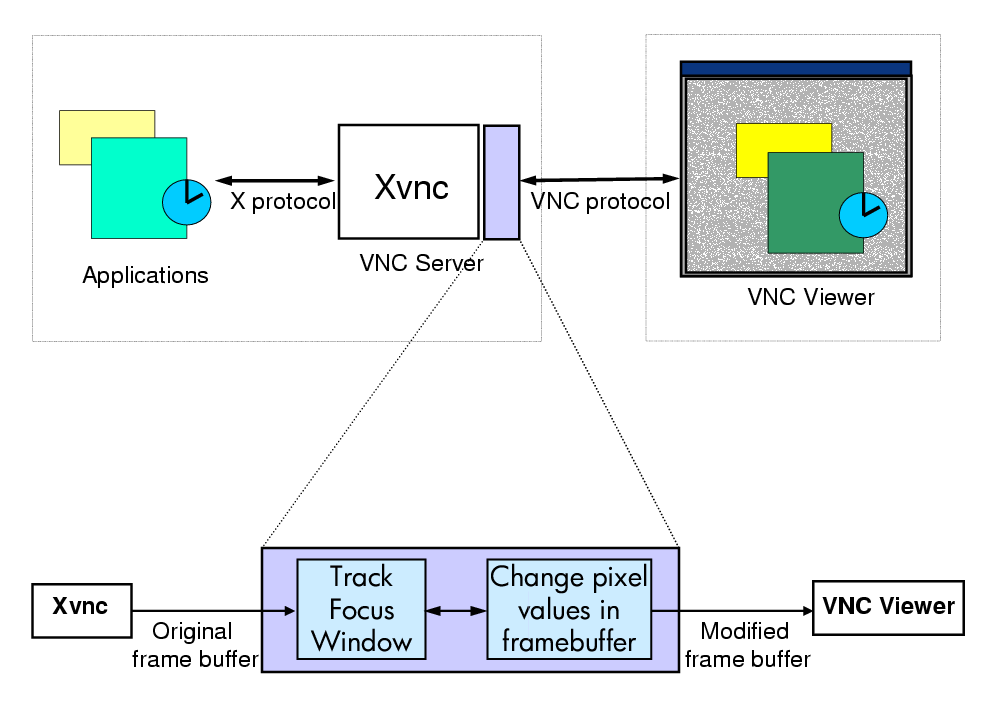
Figure 5 shows an overview of our changes. We modified the X-VNC server with two additional functions - to track the window of focus and other objects in the display area, and to change the values of the pixels in the frame buffer based on our dark-windows algorithms. To reduce the performance overhead from our software changes, our modifications closely track the incremental change update mechanism of the VNC protocol.1 Each framebuffer update represents a region that has changed, and is sent to the viewer as required to keep the display up-to-date. Before each frame buffer update is sent to the viewer, we perform two functions. First, we query the X-server and record the window of focus - the window that keyboard events are directed to - including its origin, width, and height. We then divide the update region into two groups - those that are in the window of focus and those that are outside it. The pixels within the window of focus are sent unmodified, while the rest have the desired transformation applied to them. Overall, the performance overhead of our implementation was negligible with performance acceptable to users.
| Interface Name | Modification |
| HalfDimmed | Areas outside the window of focus are dimmed by 50%. |
| FullyDimmed | Areas outside the window of focus are fully dimmed (turned off). |
| GrayScale | Areas outside the window of focus are changed to gray, by setting red, green, and blue values to the average of the three. |
| GreenScale | Areas outside the window of focus are changed to green (lowest power color for OLEDs). The green value is set to the average of the three colors, and the red and blue values are zeroed. This also dims the screen by 67%. |
Quantifying energy benefits for typical users. Though we used VNC for implementation convenience, we still wanted to focus our benefits study on the commodity Microsoft Windows based systems used in our user study. We therefore constructed a synthetic trace that modeled the average behavior observed in our user study and replayed it on our prototype systems. The trace runs for about 1000 seconds and uses a set of applications similar in nature to those used in the user study. The script for the trace models the initiation and termination of applications and varies the window sizes and the duration of time windows were open to obtain statistics consistent with the user study. While the users in our test population used a variety of backgrounds and window colors, a majority of them used the default windows settings. Our synthetic trace therefore predominantly uses those colors. To bracket the impact of specific user choices in this respect, we also performed experiments where the screen background and window colors are varied. Figure 7 summarizes the window properties of the synthetic trace and a comparison of the data with that in Figure 4 shows the close correlation between the behavior of the trace and the user study.
| Avg. window size | 59% |
| Avg. background windows' size | 17% |
| 0-25% screen usage | 23% |
| (taskbar, xterms, miscellaneous) | |
| 25-50% screen usage | 22% |
| (xterms, editors, mail readers, miscellaneous) | |
| 50-75% screen usage | 28% |
| (web browsers, mail readers, editors, miscellaneous) | |
| 75-100% screen usage | 27% |
| (web browsers, mail readers, miscellaneous) | |
| Default screen background | Teal |
| Default window color | White |
| Default foreground font | Black |
Given the current unavailability of 15" OLED displays (aside from rare prototypes), we decided to use a software power model representative of future systems. The model computes the display sub-system power as the sum of the controller power, the driver power, and the display panel power. The controller and driver power are modeled as constant values irrespective of what is displayed on the screen. The panel power represents the pixel array power and is the total of the power consumed by each pixel in the panel array. In turn, the power consumed by each pixel is proportional to the brightness of the red, green, and blue components.
Display Power = Pcontroller + Pdriver + Panel PowerThe values of the parameters of the power model were chosen to represent likely future OLED displays, and were validated by discussions with researchers working in the area and by inspecting data sheets of current displays. For the 15" display we model, we set Pcontroller to 0.5W and Pdriver to 1W. The Panel Power can be a maximum of 8.5W. Interestingly, with current OLED technologies, pixels consume different amounts of power based upon the particular color, with green typically being the lowest. For a 1024x768 resolution display with pixel values ranging from 0 (off) to 1 (fully on), the values for Pred, Pgreen, and Pblue are 4.3mW, 2.2mW, and 4.3mW.
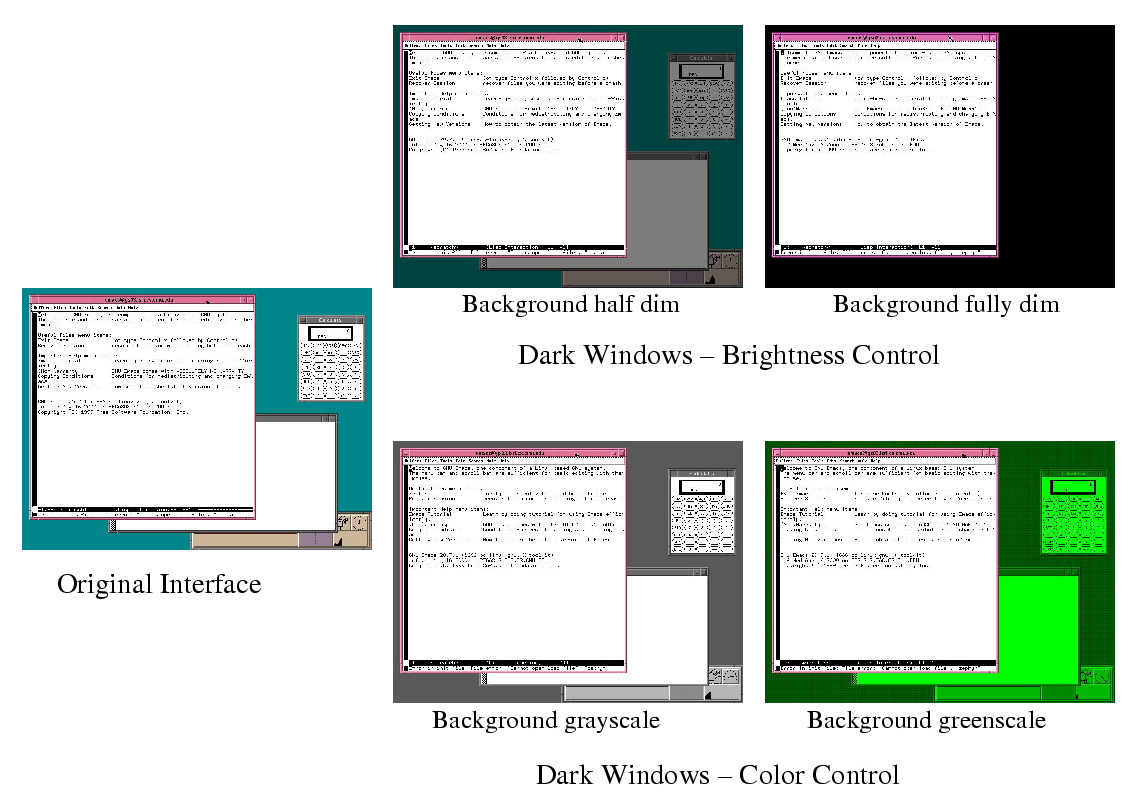
To determine the difference in the quality of the various interfaces, we informally surveyed 9 users. We asked each user two questions. First, without describing any battery life issues, we asked users to choose their best interface. Second, we showed the users the battery life advantages from the various dark-windows modifications and then asked users to choose their best interface again, with the assumption that they were in a situation that required long battery life, such as a meeting or an airplane trip. Most of the users indicated a willingness to use dark windows optimizations to tradeoff longer battery life for a different user interface. Of the 9 users we queried, 4 of them preferred GreenScale, 3 preferred HalfDimmed, and 2 preferred FullyDimmed. Most of the users expressed a desire to be able to see the contents of the background, even at the expense of some energy. Interestingly, even without an awareness of the energy benefits, four of the users chose some of the dark windows interfaces (GrayScale and HalfDimmed) as their preferred interface. Note that even without the software dark windows' optimizations, the base energy-adaptive display hardware still provides the ability to have lower power consumption based on what is displayed on the screen. Compared to LCDs, this can achieve some power benefits with no changes in the user interfaces.
Our user interfaces could be improved in several ways (we discuss these in Section 4). However, our goal was not to perform an exhaustive exploration of the design space for user interfaces, but instead to establish that energy-adaptive display sub-systems can provide energy benefits with interfaces that users are likely to find acceptable, particularly in return for longer battery lifetimes.Energy Measurements. Each of our interfaces modifies the pixels in a different manner, resulting in differing energy use. We measure the power consumed by our synthetic trace for each configuration on our modified VNC server. We study a default LCD configuration, a default OLED configuration, and four OLED configurations with the four dark windows optimizations discussed earlier. We use the OLED power model discussed earlier to compute the power for the five OLED configurations. The LCD power model is based on characteristics noted by Choi et al. [1]. For our synthetic trace, this leads to very little variance (less than 1%).
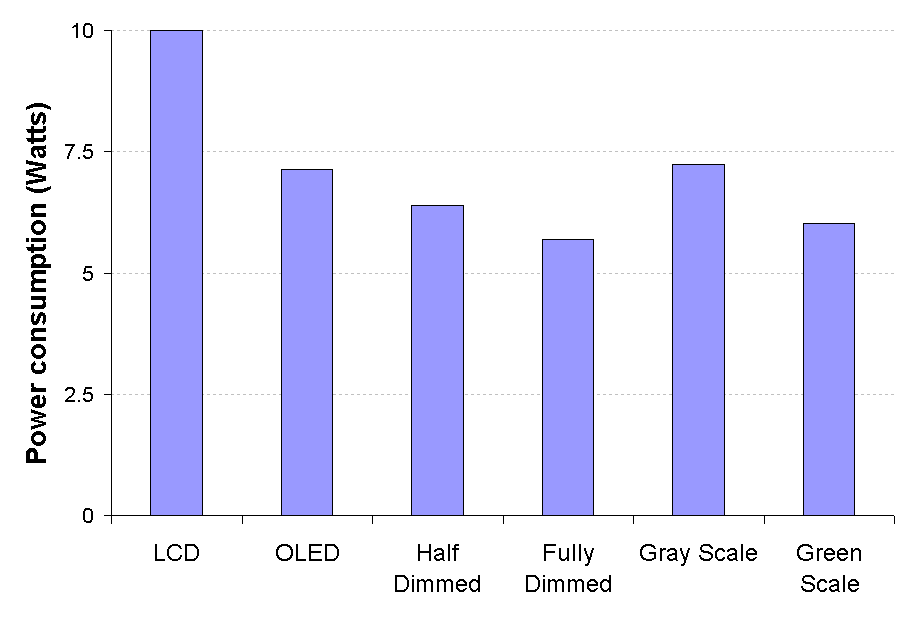
Figure 9 summarizes the results. Compared to the constant 10W power consumption of the LCD, the hardware support for energy-adaptive displays in the base OLED system achieves a 25% reduction in power. Most of these benefits are due to power reductions for the teal background color. (With our OLED display, a teal pixel - RGB: [0,131,131] consumes only 30% of the maximum power a pixel can consume - RGB: [255,255,255].) However, there are also some benefits from power reduction specific to the content of the windows (e.g., web browser). The software dark windows changes can provide additional power reductions. The FullyDimmed optimization provides an additional 20% over the OLED case, and a total of 43% over the LCD case. These benefits are from dimming of the background windows (predominantly white) and the screen background (teal). HalfDimmed provides half these benefits while still allowing some of the information to be visible. The GreenScale optimization provides 40% energy benefits compared to LCD (and a 15% benefit compared to OLED). This optimization computes the average of the R, G, B values and includes it as the new value for the green pixel. (Recall that the green pixel takes the lowest energy compared to the other pixels.) The combination of using the most energy-efficient color and a reduction in brightness by 67% leads to the energy benefits. In contrast the GrayScale optimization averages the R, G, B values and uses this average as the new values for the R, G, and B pixels, turning them gray. However, our results indicate a 1% increase in energy with this configuration compared to OLED (though still 28% better than the non-adaptive LCD case). This is because converting our default background color (RGB: [0,131,131]) to gray scale ends up moving more bits to the higher-power R and B pixels (gray-RGB: [87,87,87]). An alternate background color such as pure blue or red may have benefited from having a grayscale background optimization.
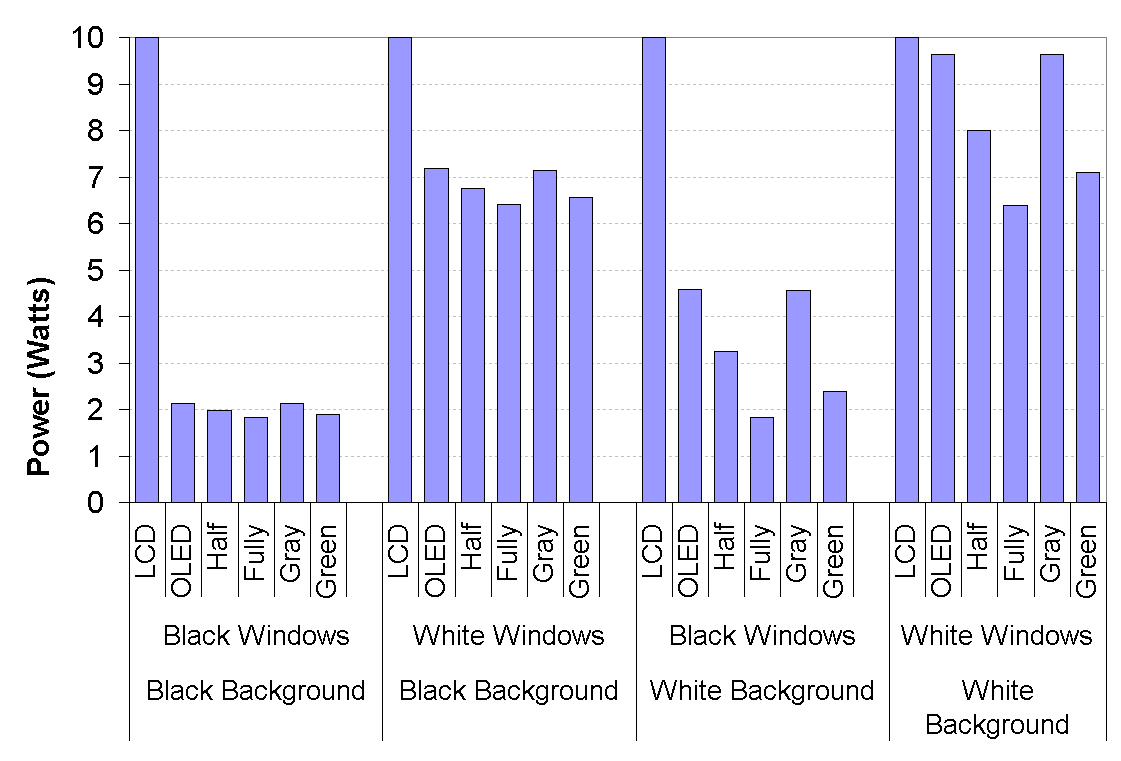
As is evident from the above discussion, the benefits from energy-adaptive display designs are highly dependent on the choices of the background color and the window color. Our default trace modeled the windows default since that most closely represented a majority of the users in our test population. To better bracket the impact of other choices of background and window colors, Figure 11 shows the energy consumption of the various configurations for the extreme cases of pure white and pure black backgrounds and window colors. With black backgrounds and black windows, the base OLED design achieves most of the benefits from energy adaptivity - close to 80% reductions compared to LCD. The power consumed is mainly due to the controller and driver and minor elements of windows such as title bars, etc. Additional software optimizations get minimal improvements on top of this. In contrast, with white backgrounds and white windows, the base OLED configuration gets close to no improvements. The FullyDimmed system gets the maximum benefits (35%) by reducing the power spent on the background. The other two cases show intermediate points where both the hardware and software optimizations obtain good benefits. These results indicate that different designs may be better for different usage scenarios. It is important for designers to understand typical user behavior before designing energy adaptive display sub systems. In some cases, it might be adequate to just include support for adaptivity at the display hardware level and choose color and size defaults with power in mind. In general, however, for systems that allow a great flexibility in user choices for background and window colors, it might be preferable to implement software optimizations in addition to the base hardware support for adaptivity.
Display energy adaptivity in software. Rather than using the window of focus, other indications of user activity could be used. For example, the area around the cursor could be kept bright, while the rest of the screen is dimmed. Another design dimension is to include support for user-controlled dimming areas. For example, one possible user interface could include a "sticky-lamp" placed by the user to light up a specific portion of the screen. Much as we do in the physical world, the user could use multiple "sticky-lamps" to light up the work-area. An alternate implementation could include a "headlight" on the mouse pointer. The users could then point the light over regions that they are interested in and move down as they read along.
Still other dimming interfaces could be application specific. For instance, in a programming environment, there may be a concept of the current procedure and related variables. Portions of the screen related to these could be made bright - for example, all uses of the variables and all calls to the procedure. In an email application, perhaps only the current message needs to be bright. In a word processor, the line of text being edited could be bright, the surrounding couple of lines lightly dimmed, and the rest of the document greatly dimmed. Similarly, in the case of applications like Microsoft Powerpoint which use frames within an application, the notion of a frame-of-focus can be defined, similar to the window of focus. As another dimension to these user interfaces, these can all be made time-based. For example, areas of the screen that have recently changed could be bright, fading to a dim value as time progresses. When inactivity is detected, an email application could dim its screen area until new mail arrives.
Other user interfaces can be developed by combining the interfaces above. Additionally, other sorts of display mismatches could be exploited. In this paper, we have focused on identifying the mismatch between the total area of the display and the area of interest to the user. Other properties of the display, such as resolution and refresh rate could be exploited as well.
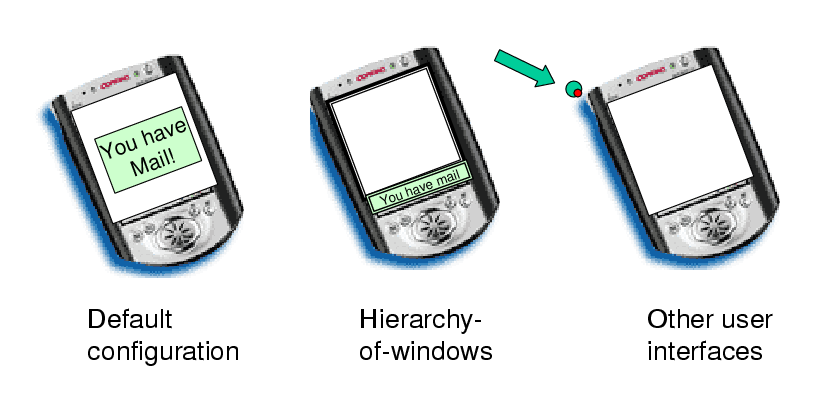
The first part of our study performs a detailed analysis of display usage traces from 17 users, representing a few hundreds of hours of active usage. To the best of our knowledge, this study is the first to identify, quantify, and analyze potential mismatch opportunities in workload/user needs and current display properties. We find that on average, the window of focus - a good indication of the area of interest to the user - uses only about 60% of the total screen area. Additionally, in many cases, the screen usage is associated with content that could have been equivalently displayed, with no loss in visual quality, on much simpler lower power displays. Our analysis of the user traces indicates that many of these mismatches could be traced back to the typical content of the windows as opposed to specific user preferences.
Based on these insights, the second part of the study proposes energy-adaptive display systems that match energy use to the functionality required by the workload/user to obtain significant energy savings. To support the energy adaptivity in hardware, our designs leverage emerging display technologies like OLEDs that provide variability in the energy consumed based on the properties of the pixels. For energy adaptivity at the software level, we propose several dark windows optimizations that allow the windowing environment to change the brightness and color of portions of the screen that are not of interest to the user. We develop prototypes of the user interfaces and model the power benefits of such energy adaptive designs. Our results indicate significant energy reductions with acceptable tradeoffs in the user interface.
In addition to the designs that we evaluate, we also discuss other points in the design space including several other alternative hardware and software interfaces for energy-adaptivity. These designs are likely to achieve even further energy benefits. Our work leads to several interesting challenges including the design of energy-aware user interfaces as well as more intelligent heuristics to automatically identify mismatches between the workload/user intent and the display sub-system functionality.As mobile systems continue to develop, the contribution of the display power to the total mobile system power is only likely to increase, particularly in larger mobile devices. Similarly, as mobile workloads continue to develop, mismatches between the display system required for the most aggressive application and the needs of the common-case workloads are only likely to get exacerbated. The combination of these trends indicate a huge potential for system designs that flexibly adapt their energy consumption based on workloads needs. We believe that energy-adaptive display designs like the ones that we discuss in this paper are an extremely promising approach to exploit this potential and that they will become an important part of future mobile system designs.
|
This paper was originally published in the
Proceedings of the
The First International Conference
on Mobile Systems, Applications, and Services,
May 5 – 8, 2003,
San Francisco, CA, USA
Last changed: 01 May 2003 djc |
|